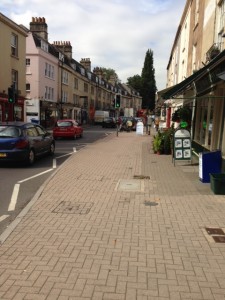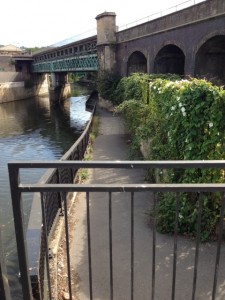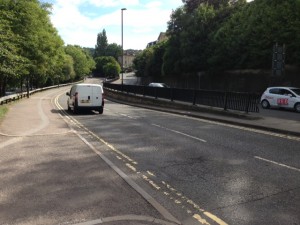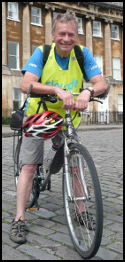When the Rossiter Road/Widcombe Parade scheme costing £1.8m is implemented, hopefully in 2014, consideration should be given on how cycling in the area can be improved.
The basics of the scheme are that Widcombe Parade traffic will be reversed and reduced by about 80% and Rossiter Road made into two-way traffic to become the bypass that Widcombe people have fought for over a period of 30 years. The present cycle lane should become a properly constituted cycle contraflow, with different coloured tarmac, preferably green to clearly identify it.
There is an opportunity to extend this cycle lane down to the Churchill Bridge as Claverton Street will still have four lanes of traffic. An east bound cycle lane could also be installed on the opposite carriageway of Claverton Street as far as the h’apenny bridge. The crucial part of any wider scheme here is to make the wide footbridge to the west near Churchill Bridge into a shared path. This would allow cycle access to Widcombe avoiding the difficult Churchill Bridge gyratory.
There is also the possibility of using the subway under the A36 as a shared path with suitable safeguards, clearly giving priority to people walking, enabling cyclists to access Holloway towards the Two Tunnels Greenway and to cross into the city.
This depends on the Council considering cycle links, not just how bikes can get safely through Widcombe.
In addition, but not as an alternative there could be an off road cycle path from the Churchill Bridge along the river towpath going east, which would avoid both Rossiter Road and Widcombe to connect with the towpath from Thimble Mill to Pulteney Bridge, St Johns Road and Cleveland Bridge. This route could provide a southerly off road route for people riding bikes through the south of the city avoiding the A36 altogether.
What is needed here is for a design for cycling roughly on the route that I have outlined, taking cyclists through Widcombe Parade as well as providing an off road southerly through route. To the west a connection with the Bristol/Bath Railway path is easy to make over the present crossing at Churchill Bridge.
I have many misgivings about a scheme that is mainly designed to ensure continued traffic flow through the area, rather than prioritising the regeneration of Widcombe Parade and its local shops. However, this is an opportunity to design for much improved safety for people on bikes. The bulk of the money is to be spent not on regenerating Widcombe Parade and improving cycling, but on improving traffic flow. Surely the time has come to shift priorities from motor traffic to people on foot and on bikes.
If the Council is serious about giving a high priority to people on bikes officers could carry out a brief study of cycle links around Widcombe. This would enable investment in both on and off road cycle links, which would be of great benefit to local people and visitors to the area and signal that the Council is prepared to take cycling seriously.






 Hello, I'm Roger Symonds and I have created this blog to highlight local and wider cycling issues. Given the incredible interest and increase in cycling we must not miss this opportunity to provide the the infrastructure that gets even more people out on bikes in a safer environment.
Hello, I'm Roger Symonds and I have created this blog to highlight local and wider cycling issues. Given the incredible interest and increase in cycling we must not miss this opportunity to provide the the infrastructure that gets even more people out on bikes in a safer environment.
not to forget also that if there is to be two way traffic on the new rossiter road then it too will need some space afforded to cycle traffic which I imagine will be overlooked.The churchill bridge area is going to need alot of thought if it is to give an easier less hazardous movement through for people who are riding bicycles.(I would suggest that its not that great at the moment for any vehicle)
If the second of the tunnels/arches under the railway were opened up it would also give an opportunity for more segregation of pedestrians and cyclists heading to and from the churchill bridge area.
Thank you for your response Tim. It may be just too difficult to provide cycle lanes on the two way part of Rossiter Road, which is why I have suggested the off road river route. A widened pavement as shared path might be the answer. I do believe that someone needs to look at the whole area for cycling. It’s only doing this that we can be sure that all aspects of cycling are covered. Opening a second arch could be looked at in such a study. Sadly there is at present no prospect of getting a study on cycling in the area looked at.
What a great idea. More cyclists will decrease contamination, save fuel, save money for the individuals and have a healthier group of people. Good luck.
Thank you Ian. That’s the aim. Thanks for looking at the web site.
For ages I have said that the gyratory underneath the railway bridge and the resulting road is a massive barrier for cycling in Bath – there are ‘suggest quiet roads’ and cycle infrastructure on the council map that is available (this one https://secure.lifecycleuk.org.uk/catalog/product/bath-and-north-east-somerset-map-for-cyclists) on both the north and south of the map, but then a massive ‘busy road’ runs straight through the middle.
I use this route to get to and from work (I cycle commute in from Midsomer Norton) and use it, however I am very well aware that I’m in a minority. Even as an experienced cyclist it is not pleasant, especially at rush hour where I have come into conflict with traffic (usually traffic behind me that doesn’t appreciate me “taking the lane” or feels that I’m taking too long to pull out from Churchill Bridge onto the A36).
However, I do fear that a poorly implemented scheme here could make my life even harder. I don’t use the existing shared use pavement on the bridge as it’s not the quickest route by a long shot. If I could have my cake and eat it, I would want a link that somehow prevented me mixing with pedestrians and not having to cede to traffic (which the current layout makes me do… I would have to cycle around St James Parade, stop and get on the pavement at some random point by the bus station, dismount to cross the zebra crossings on foot because technically I shouldn’t cycle over it, remount and slowly pedal along the shared use pavement, dismount to use the crossing as it’s not a toucan crossing and there are ‘cyclists dismount’ signs, get back on and go underneath the railway bridge and up the narrow shared path, then cross back onto the Wells Road across two busy lanes of traffic and climb the hill mixing with traffic).
What I fear is that any implementation along the A36 and Widcombe would do the same for other cyclists.
Don’t get me wrong, I’m not a diehard “John Franklin” style cyclist who is demanding my right to use the road as per Cyclecraft, but I do worry about half-hearted schemes that would make my commute much slower (I can currently get into work in the same time it used to take me to drive, any “infrastructure” that makes that journey longer ruins part of the point of commuting by bike). What I want is routes away from traffic where I’m also not brought into conflict with pedestrians or constantly having to stop to cross roads. Your post mentions “shared paths” a fair bit. This doesn’t “shift priorities from motor traffic to people on foot and on bikes” – it creates conflicts between the two users and slows down bike travel. And when people like me continue to use the road because it’s three/four times quicker it introduces even more hostility from motor vehicles who feel I should be “using the facilities provided”.
Another point to note about the subway – I was at a Cycle Bath meeting once with a representative from the council who intimated that there is a patch of land leading to the entrance which had unclear ownership, and to compulsory purchase it would require great expense (as they would have to place notices in the paper for a set amount of time etc) – do you know if this is still the case?
Thanks for responding Robert. I have put together a number of things that can be done in Widcombe, when at present there is only consideration (and argument) about how cyclists can get through Widcombe Parade (where the shops are). Should they go by contra flow or be taken through the car park to the north of Widcombe Parade. The scheme should be about regenerating Widcombe and sending people on bikes who are likely to stop and spend money away from the shops contradicts this. I have tried to expand this and to show the opportunities that there are for cycle routes and links to other areas.
For commuters like yourself directness and speed are the main considerations (and safety of course). After a woman was knocked off her bike at the bottom of Wells Road on the giratory at Churchill Bridge, Council officers’ reaction was that cyclists should keep away because this area is too dangerous – shows how far we have to go with raising the priority of cycling. In other words too difficult so we don’t do anything.
I would like a study by someone who knows about cycling, to be done for the whole area looking at commuters and leisure and touring cyclists. In terms of links for leisure and touring cyclists, opening up the river towpath would give a clear southerly off road bypass route, which could connect with the Railway Path to the west and possibly NCN 4 on the canal to the east, but i would like to see on road cycle lanes here where space is taken away from motor vehicles.
Discussions are still going on and Nigel Sherwen has submitted comments for the cycling lobby – he is not happy.
I see no mention of opening up the Widcombe Ha’penny Bridge for shared use, which is meant to be a part of BANES’s Strategic Cycling Routes. It’s plenty wide enough, as is proved by the success of Fielding’s Road bridge (I’ve haven’t stuck a tape measure across it, but that appears even slightly narrower than the one at Widcombe). Ingress across the bridge facilitates movement not only to Widcombe High St. but also to the river path between Rossiter Rd & Grove St.
Thanks for picking this up Dave. I didn’t mention it because it would be pounced on by the anti-cycling lobby. At present the barriers funnel people walking and on bikes into a very small space, so the barriers have the affect of pushing people together. Its amazing how polite people are in letting others go first though. It proves to me that if there were no barriers and no signs the bridge would work perfectly well and that the vast majority of people on foot or on bikes can co-operate. Personally I ride across the bridge very slowly always giving way to people on foot.